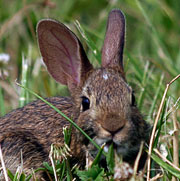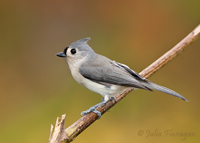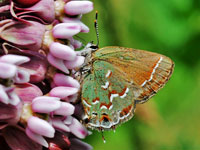 |
|
IN THIS ISSUE
Volunteer - Conservation Landscape Work Day
1st Thursday - Virginia Public Access Project
A Success Story - Vantage Point Development Site Tour
Merrimac Farm Bird Walk
Going Native!

|
|
Every little bit helps. It's amazing how much you can do when you choose to give a little bit of that natural habitat back.
- Roxanne Paul |
Last Month at the Bird Walk at Merrimac Farm...
The sky was clear and temperatures were in the low 80's for the end of the month wildlife survey at Merrimac Farm on Sunday, July 31.
A half dozen people toured mostly upland habitats and we were interested to see that flowering plants are beginning to shift from summer to fall blooming species.
Purple-headed Sneezeweed, Blue Mist Flower, Rose Pinks, and Queen Anne's Lace were plentiful and in full bloom.
Several species of Goldenrod are about to light up fields and forest edges, and the Bonesets won't be far behind.
We had an exciting start to the morning when we spotted a gang of Wild Turkeys along the road to the Stone House. We counted about 20, and close to half of these were babies.
Over the course of the morning, we sighted 31 different birds and 15 species of butterflies.
BIRD LIST
July 31 2011
Wild Turkey
Turkey Vulture
Yellow-billed Cuckoo
Ruby-throated Hummingbird
Belted Kingfisher
Red-bellied Woodpecker
Downy Woodpecker
Acadian Flycatcher
Great Crested Flycatcher
Eastern Kingbird
White-eyed Vireo
Yellow-throated Vireo
Red-eyed Vireo
Blue Jay
American Crow
Carolina Chickadee
Tufted Titmouse
Carolina Wren
House Wren
Blue-gray Gnatcatcher
Eastern Bluebird
Wood Thrush
American Robin
Gray Catbird
Cedar Waxwing
Prairie Warbler
Eastern Towhee
Field Sparrow
Northern Cardinal
Indigo Bunting
AmericanGoldfinch
BUTTERFLY LIST
July 31 1011
Zebra Swallowtail
Eastern Tiger
Swallowtail
Spicebush Swallowtail
Cabbage White
Great-spangled Fritillary
Pearl Crescent
Eastern Comma
Common Buckeye
Viceroy
Common Wood
Nymph
Monarch Silver-spotted Skipper
Horace's Duskywing
Peck's Skipper
Zabulon Skipper |
|
| Volunteer! Merrimac Farm Conservation Landscape Prep for Fall Planting |
 When: Saturday, Sept. 24 and Saturday Oct. 15, beginning at 9:00 am When: Saturday, Sept. 24 and Saturday Oct. 15, beginning at 9:00 am
Where: Merrimac Farm Stone House, 15020 Deepwood Lane, Nokesville
Questions & RSVP (appreciated but not required): [email protected], 703-499-4954
Sept. 24 - We are going to eliminate a little over a half acre of nonnative grasses behind the Stone House by laying down old developer site plans and then covering the area with compost. Click here to read more about the benefits of replacing grass with native plants.
We have 37 cu. yards of compost to spread... we'll need lots of help! Useful tools to bring include shovel, pitchfork, rake, and wheelbarrow. Food and drinks provided. We appreciate your help.
Oct. 15 - Planting Day. |
|
Virginia Public Access Project |
 1st Thursday Speaker Series 1st Thursday Speaker Series
When: Thursday, Oct 6, 7:30-9:00pm Where: Bull Run Unitarian Church, 9350 Main Street, Manassas
Speaker: David Poole, Virginia Public Access Project
The Virginia Public Access Project (VPAP) is a nonprofit group that uses technology to improve public understanding of money's role in Virginia politics. VPAP was formed to address a long-standing problem with Virginia's system of financing state and local election campaigns.
In Virginia the sky is the limit, as long as candidates file reports that identify donors who give more than $100. Before VPAP was formed, the public had no practical way to view — much less analyze — the paper disclosure reports on file at the State Board of Elections and local voter registrars.
Please join us to learn more about VPAPs initiative to shine "digital sunlight" on money raised by candidates for Virginia office. |
|
|
| A Success Story: Vantage Point Development Site Tour |
 How a Northern Virginia Site Near Occoquan was "Conserved" and "Developed" at the Same Time How a Northern Virginia Site Near Occoquan was "Conserved" and "Developed" at the Same Time
When: Thursday, Oct 8, 10:00 am
Where: Vantage Point Development Site
RSVP to alliance @pwconserve.org for directions to parking location
Please join PWCA, Kettler, Occoquan District Supervisor Mike May and Town of Occoquan Mayor Earnie Porta for a tour of the Vantage Point site and hear various solutions considered and rejected/adopted, for a real-world parcel to be developed.
Conservation easements permanently protect ecological, historic, and/or scenic resources. In Virginia, landowners who permanently conserve their property may qualify for a state tax credit and federal tax deduction, which partially compensate private landowners for their economic sacrifice.
Conservation easements are also a useful planning tool. Although tax incentives generally aren't available, developers who donate conservation easements easements as part of development projects are making an enforceable commitment to permanently protect conservation areas, benefiting all involved parties.
The recent Vantage Point rezoning in the Occoquan District is a case in point. Located at the intersection of Tanyard Hill and Old Bridge Roads, the plan for this site uses a conservation easement to permanently protect steep slopes, streams, and trees, and the scenic entrance to the Town of Occoquan. A new community will be developed with commitments that protect the quality of both conservation and surrounding areas. |
|
|
|
 When: Sunday, Sept. 25 28 & Sunday, September 25, 8:00 am When: Sunday, Sept. 25 28 & Sunday, September 25, 8:00 am
Where: Meet at the Stone House at Merrimac Farm, 15020 Deepwood Lane, Nokesville
Please join us for the regularly scheduled (last Sunday of the month) bird walk at Merrimac Farm. We travel through the uplands to the edge of the floodplain, covering a variety of habitats including open fields and woodland edges. Everyone is welcome. Dress for the weather, bring binoculars and cameras. More info and RSVP (not required) to PWCA , 703.499.4954 or alliance(at)pwconserve.org. |
|
|
 Invasive plants are destructive and virtually impossible to remove once they become established. Look at a kudzu-draped forest or a waterway choked with hydrilla. Invasive plants are destructive and virtually impossible to remove once they become established. Look at a kudzu-draped forest or a waterway choked with hydrilla.
These invasives are killers, cutting off oxygen and sunlight to native plants, weakening them and eventually outcompeting them. Millions of dollars are spent annually trying to eradicate invasive plants without success.
Another type of costly invasive we're all familiar with—and even nurture—is grass. Many of the varieties in our lovely green lawns are not native to Prince William County, Virginia, or even the United States. For example, Kentucky bluegrass, despite its name, originated in Europe, Asia and northern Africa.
There are several significant drawbacks to the maintenance of a sweeping expanse of grass. The custom of growing a luxurious lawn originated in England, where there was sufficient rainfall to support the native plants. Many areas of the US are too dry to cultivate a large area of non-native grasses without using a huge amount of water—50 to 70 percent of residential water use in the summer. Keep reading... |
|
|